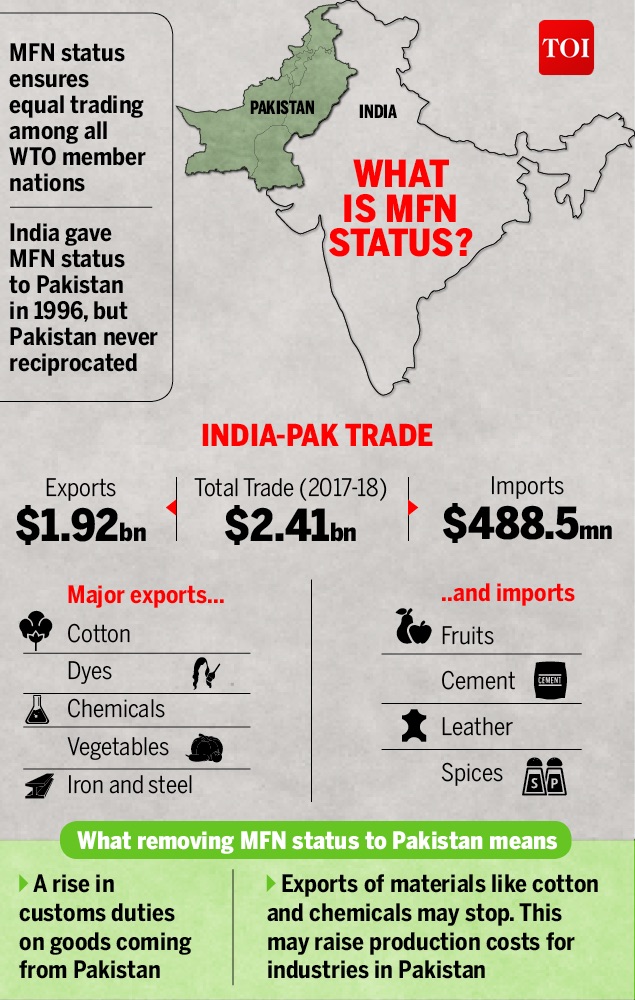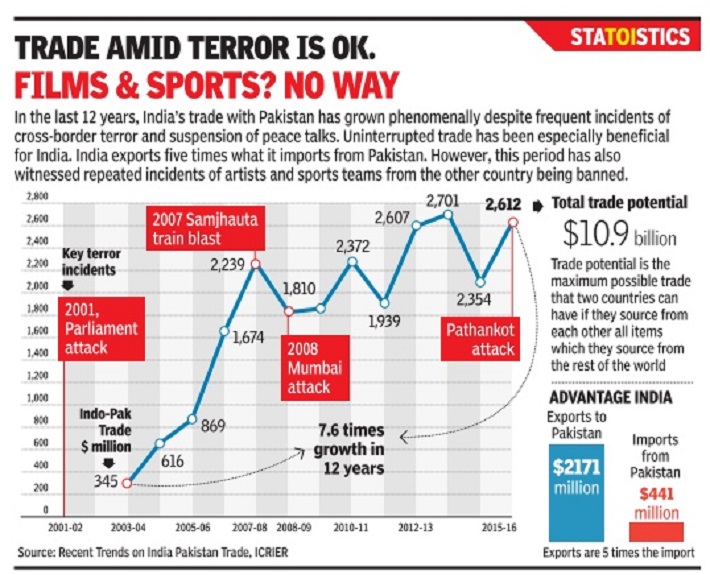Pakistan- India economic relations
(→Most-Favoured-Nation (MFN) status) |
|||
| Line 6: | Line 6: | ||
|} | |} | ||
| − | [[ | + | |
| − | [[ | + | |
| − | [[ | + | |
| − | [[ | + | |
| + | |||
| + | =Backgrounders= | ||
| + | ==1995- 2018== | ||
| + | [https://timesofindia.indiatimes.com/india/why-pakistan-stands-to-lose-big-in-trade-war-with-india/articleshow/70752104.cms August 23, 2019: ''The Times of India''] | ||
| + | |||
| + | [[File: Bilateral exports as proportion of total exports, 1995-2018.jpg|Bilateral exports as proportion of total exports, 1995-2018 <br/> From: [https://timesofindia.indiatimes.com/india/why-pakistan-stands-to-lose-big-in-trade-war-with-india/articleshow/70752104.cms August 23, 2019: ''The Times of India'']|frame|500px]] | ||
| + | |||
| + | [[File: Bilateral imports as proportion of total imports, 1995- 2018.jpg|Bilateral imports as proportion of total imports, 1995- 2018 <br/> From: [https://timesofindia.indiatimes.com/india/why-pakistan-stands-to-lose-big-in-trade-war-with-india/articleshow/70752104.cms August 23, 2019: ''The Times of India'']|frame|500px]] | ||
| + | |||
| + | [[File: Pakistan's share in India's total imports (%); Top 3 goods, 2019.jpg|Pakistan's share in India's total imports (%); Top 3 goods, 2019 <br/> From: [https://timesofindia.indiatimes.com/india/why-pakistan-stands-to-lose-big-in-trade-war-with-india/articleshow/70752104.cms August 23, 2019: ''The Times of India'']|frame|500px]] | ||
| + | |||
| + | [[File: India's share in Pakistan's total imports (%); Top 10 goods, as in 2019.jpg|India's share in Pakistan's total imports (%); Top 10 goods, as in 2019 <br/> From: [https://timesofindia.indiatimes.com/india/why-pakistan-stands-to-lose-big-in-trade-war-with-india/articleshow/70752104.cms August 23, 2019: ''The Times of India'']|frame|500px]] | ||
| + | |||
| + | [[File: Pakistan's share in India's total exports (%); Top 3 goods, as in 2019.jpg|Pakistan's share in India's total exports (%); Top 3 goods, as in 2019 <br/> From: [https://timesofindia.indiatimes.com/india/why-pakistan-stands-to-lose-big-in-trade-war-with-india/articleshow/70752104.cms August 23, 2019: ''The Times of India'']|frame|500px]] | ||
| + | |||
| + | [[File: India's share in Pakistan's total exports {%}; Top 10 goods, as in 2019.jpg|India's share in Pakistan's total exports {%}; Top 10 goods, as in 2019 <br/> From: [https://timesofindia.indiatimes.com/india/why-pakistan-stands-to-lose-big-in-trade-war-with-india/articleshow/70752104.cms August 23, 2019: ''The Times of India'']|frame|500px]] | ||
| + | |||
| + | |||
| + | ''' The ongoing trade war between India and Pakistan will hit Islamabad hard as it is dependent on India as far as bilateral trade is concerned ''' | ||
| + | |||
| + | On August 9, Pakistan formally suspended trade relations with India in response to the revocation of the special status of Jammu & Kashmir. In 2018, according to data collated by United Nations Conference on Trade and Development, bilateral trade between India and Pakistan was worth $2.8 billion, of which $2.3 billion was India’s exports to and $500 million its imports from Pakistan. | ||
| + | |||
| + | |||
| + | ''' 1. Pakistan is more dependent on India for its exports ''' | ||
| + | |||
| + | Pakistan’s dependence on India is slightly higher than India’s on its neighbour. India’s exports to Pakistan are 0.73% of its total exports while India accounts for 1.62% of Pakistan’s exports. | ||
| + | |||
| + | ''' 2. Pakistan’s imports from India are five times India’s imports from Pakistan ''' | ||
| + | |||
| + | When it comes to imports, India is even less dependent on Pakistan. In 2018, Pakistan accounted for 0.09% of India’s total imports. India constitutes 3.9% of Pakistan’s total imports. | ||
| + | |||
| + | ''' 3. India, the largest importer of Pakistani cement ''' | ||
| + | |||
| + | Cement is the only good with a significant chunk coming from Pakistan. No other commodity imported from Pakistan is more than 10% of India’s total imports. | ||
| + | |||
| + | ''' 4. Pakistan is hugely reliant on India for 40 commodities ''' | ||
| + | For 40 commodities, Pakistan’s imports from India constitute more than 10% of its total imports. For 17 of these goods, more than one- fourth of Pakistan’s imports come from India. These commodities are likely to become costlier in Pakistan. | ||
| + | |||
| + | ''' 5. Trade ban could hit exporters in both India and Pakistan ''' | ||
| + | |||
| + | While an import ban will push up domestic prices, an export ban can hurt domestic producers, who may struggle to find new markets. Pakistan is a big market for India’s animal oils and cotton. | ||
| + | |||
| + | ''' 6. For 26 goods, more than 10% of Pak’s exports go to India ''' | ||
| + | |||
| + | There are 13 commodities for which more than one-fourth of Pakistan’s total exports go to India and the ban will badly impact its domestic producers. | ||
| + | |||
| + | |||
| + | ''' Pakistan’s actions have backfired before ''' | ||
| + | |||
| + | After the Pulwama terror attack in February and the Balakot strike, Pakistan closed its airspace to Indian flights in retaliation. Though the closure was meant to stifle flights to and from India, it ended up hurting Pakistan considerably. | ||
| + | |||
| + | While airlines lost time and money on rerouting flights, Pakistan lost millions in overflight fees earned when planes pass through foreign airspace. About 400 flights a day avoided Pakistani airspace, resulting in losses of $100 million since the closure, which was lifted on July 12 | ||
| + | |||
| + | ''' What is air toll? ''' | ||
| + | |||
| + | Airlines pay civil aviation administration of the country they are flying over a certain fee based on the type of aircraft, the distance covered while overflying a country and the weight of an aircraft before it takes off. For a Boeing 737, Pakistan charges $580. The amount will rise in case of larger aircraft like the Airbus 380 or Boeing 747. The rates differ from one country to another | ||
| + | |||
| + | |||
| + | ==2015-20== | ||
| + | [https://timesofindia.indiatimes.com/india/explained-why-india-pakistan-are-talking-trade-again/articleshow/81781815.cms April 1, 2021: ''The Times of India''] | ||
| + | |||
| + | [[File:India's exports and imports with Pakistan, 2015- 20, year-wise.jpg|India's exports and imports with Pakistan, 2015- 20, year-wise <br/> From: [https://timesofindia.indiatimes.com/india/explained-why-india-pakistan-are-talking-trade-again/articleshow/81781815.cms April 1, 2021: ''The Times of India'']|frame|500px]] | ||
| + | |||
| + | [[File: India has trade surplus with Pakistan, 2015- 20.jpg|India has trade surplus with Pakistan, 2015- 20 <br/> From: [https://timesofindia.indiatimes.com/india/explained-why-india-pakistan-are-talking-trade-again/articleshow/81781815.cms April 1, 2021: ''The Times of India'']|frame|500px]] | ||
| + | |||
| + | [[File: India's trade with Pakistan, 2015-20.jpg|India's trade with Pakistan, 2015-20 <br/> From: [https://timesofindia.indiatimes.com/india/explained-why-india-pakistan-are-talking-trade-again/articleshow/81781815.cms April 1, 2021: ''The Times of India'']|frame|500px]] | ||
| + | |||
| + | [[File: India's trade with Bangladesh, 2015-20, year-wise.jpg|India's trade with Bangladesh, 2015-20, year-wise <br/> From: [https://timesofindia.indiatimes.com/india/explained-why-india-pakistan-are-talking-trade-again/articleshow/81781815.cms April 1, 2021: ''The Times of India'']|frame|500px]] | ||
| + | |||
| + | Explained: Why India, Pakistan are talking trade again | ||
| + | |||
| + | ''' The news ''' | ||
| + | |||
| + | Pakistan has allowed private companies to import sugar and cotton from India. The move signals a revival of trade ties between the two neighbours. "India desires normal relations, including on trade with all countries, including Pakistan. Pakistan unilaterally suspended bilateral trade with India in August 2019. It is for Pakistan to review its unilateral measures on trade," minister of state for commerce and industry Hardeep Singh Puri had said in the Lok Sabha last month. | ||
| + | |||
| + | ''' The freeze ''' | ||
| + | |||
| + | After the Pulwama terror attack in February 2019, India withdrew the 'most-favoured nation' (MFN) status it had unilaterally granted to Pakistan in 1996 as a member of World Trade Organisation (a Pakistan cabinet decision of November 2, 2011 to reciprocate remains unimplemented). Withdrawing MFN status meant India could make all goods imported from Pakistan more expensive (and therefore unviable) by imposing a customs duty of 200% on them. | ||
| + | This was followed by suspension of cross-border trade in April 2019, which India then said was being misused for funnelling in illegal weapons, narcotics, and fake currency. Pakistan announced complete suspension of all bilateral trade after the Indian government revoked the special status of Jammu and Kashmir on August 5, 2019. Pakistan made a partial relaxation in September 2019 for trade in medicines. | ||
| + | |||
| + | ''' The thaw ''' | ||
| + | |||
| + | |||
| + | There’s been a gradual thawing in ties between the two neighbours since the announcement of ceasefire along the Line of Control in February this year. This was followed by Pakistani Prime Minister Imran Khan advocating dialogue between the two countries and its army chief talking of stable ties. Prime Minister Narendra Modi had also written a letter to PM Khan extending greetings on the occasion of Pakistan Day on March 23. | ||
| + | |||
| + | ''' The need ''' | ||
| + | |||
| + | While it is yet to be seen if trade between the two countries will expand across all commodities, the choice of sugar and cotton to make a start wasn’t surprising. Pakistan was one of the leading buyers of Indian cotton before the trade ban two years ago (it imported over $550 million of cotton in 2018-19). But recently, there have been reports of Pakistan’s textile sector struggling to source cotton at the right price following a low yield of cotton in the country. India is not just the world's biggest producer of cotton, it can offer the commodity to its neighbour at cheaper rates than suppliers from other countries. | ||
| + | |||
| + | India is also the second biggest sugar producer and Pakistan has been facing a crisis with domestic sugar prices soaring. Its attempts to tap the international market haven’t borne fruit due to the high cost. Pakistani traders have been buying Indian sugar from their offices in Dubai or Afghanistan, according to Reuters, but with direct imports from India, the cost comes down substantially. While sugar imports will help Pakistan lower soaring prices ahead of Ramadan, it will also help India reduce surpluses that are weighing on its local markets. | ||
| + | |||
| + | ''' The trade ''' | ||
| + | |||
| + | Trade relations between India and Pakistan have always mirrored the political ties between the two neighbours. And this means direct trade has remained more or less stagnant (indirect and informal trade through Dubai isn’t accounted for in the official numbers). Before the ban, trade between both nations had stood at just $2.5 billion in 2018-19, accounting for a mere 0.3% of India’s total trade with the world and just over 3% of Pakistan’s global trade. The ban dried even that up. In calendar year 2020, India’s exports to Pakistan dipped 76.3% to $283 million while imports plummeted 96.2% to just $2.5 million. In contrast, India’s trade with its eastern neighbour Bangladesh has grown in recent years. | ||
| + | |||
| + | |||
| + | ''' Advantage India ''' | ||
| + | |||
| + | Though the volume of trade between India and Pakistan has been low, the balance of trade has been heavily skewed in favour of India, which means India sells much more to Pakistan than it buys. Opening up of bilateral trade, therefore, will be more beneficial to India. | ||
| + | |||
| + | India mainly exports cotton, dyes, chemicals, plastics, vegetables and iron and steel. It imports fruits, cement, leather and spices. | ||
| + | |||
| + | |||
| + | ''' The potential ''' | ||
| + | |||
| + | What if the two largest economies in South Asia traded like normal neighbours? | ||
| + | |||
| + | According to a 2018 World Bank study (A Glass Half Full: The Promise of Regional Trade in South Asia), the trade potential between India and Pakistan stands at $37 billion. The report also highlighted how India and Pakistan maintained long, sensitive lists of items on which no tariff concessions are granted but in practice many of these items reach Pakistan via a third country like the United Arab Emirates, adding to the cost. The lack of normal bilateral trade relations also affects the formation or deepening of regional value-chains in many high-value trading sectors, the report highlighted. | ||
=E-commerce= | =E-commerce= | ||
| Line 137: | Line 245: | ||
[[Category:India|E | [[Category:India|E | ||
PAKISTAN- INDIA ECONOMIC RELATIONS]] | PAKISTAN- INDIA ECONOMIC RELATIONS]] | ||
| − | + | ||
[[Category:Pakistan|E | [[Category:Pakistan|E | ||
PAKISTAN- INDIA ECONOMIC RELATIONS]] | PAKISTAN- INDIA ECONOMIC RELATIONS]] | ||
| Line 179: | Line 287: | ||
and many more articles, especially about the 1965 and 1971 wars, [[The Kargil war of 1999]], 1947... | and many more articles, especially about the 1965 and 1971 wars, [[The Kargil war of 1999]], 1947... | ||
| + | |||
| + | [[Category:Economy-Industry-Resources|E PAKISTAN- INDIA ECONOMIC RELATIONS | ||
| + | PAKISTAN- INDIA ECONOMIC RELATIONS]] | ||
| + | [[Category:Foreign Relations|P PAKISTAN- INDIA ECONOMIC RELATIONS | ||
| + | PAKISTAN- INDIA ECONOMIC RELATIONS]] | ||
| + | [[Category:India|E PAKISTAN- INDIA ECONOMIC RELATIONS | ||
| + | PAKISTAN- INDIA ECONOMIC RELATIONS]] | ||
| + | [[Category:Pages with broken file links|PAKISTAN- INDIA ECONOMIC RELATIONS | ||
| + | PAKISTAN- INDIA ECONOMIC RELATIONS]] | ||
| + | [[Category:Pakistan|E PAKISTAN- INDIA ECONOMIC RELATIONS | ||
| + | PAKISTAN- INDIA ECONOMIC RELATIONS]] | ||
Revision as of 20:29, 1 April 2021
This is a collection of articles archived for the excellence of their content. |
Contents |
Backgrounders
1995- 2018
August 23, 2019: The Times of India
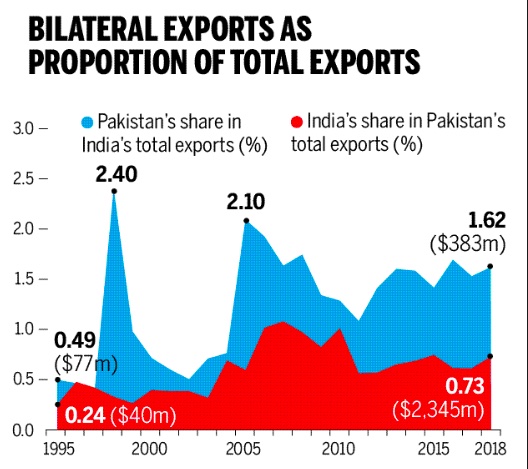
From: August 23, 2019: The Times of India

From: August 23, 2019: The Times of India
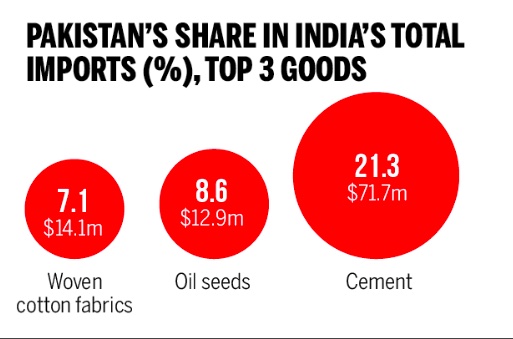
From: August 23, 2019: The Times of India

From: August 23, 2019: The Times of India

From: August 23, 2019: The Times of India
[[File: India's share in Pakistan's total exports {%}; Top 10 goods, as in 2019.jpg|India's share in Pakistan's total exports {%}; Top 10 goods, as in 2019
From: August 23, 2019: The Times of India|frame|500px]]
The ongoing trade war between India and Pakistan will hit Islamabad hard as it is dependent on India as far as bilateral trade is concerned
On August 9, Pakistan formally suspended trade relations with India in response to the revocation of the special status of Jammu & Kashmir. In 2018, according to data collated by United Nations Conference on Trade and Development, bilateral trade between India and Pakistan was worth $2.8 billion, of which $2.3 billion was India’s exports to and $500 million its imports from Pakistan.
1. Pakistan is more dependent on India for its exports
Pakistan’s dependence on India is slightly higher than India’s on its neighbour. India’s exports to Pakistan are 0.73% of its total exports while India accounts for 1.62% of Pakistan’s exports.
2. Pakistan’s imports from India are five times India’s imports from Pakistan
When it comes to imports, India is even less dependent on Pakistan. In 2018, Pakistan accounted for 0.09% of India’s total imports. India constitutes 3.9% of Pakistan’s total imports.
3. India, the largest importer of Pakistani cement
Cement is the only good with a significant chunk coming from Pakistan. No other commodity imported from Pakistan is more than 10% of India’s total imports.
4. Pakistan is hugely reliant on India for 40 commodities For 40 commodities, Pakistan’s imports from India constitute more than 10% of its total imports. For 17 of these goods, more than one- fourth of Pakistan’s imports come from India. These commodities are likely to become costlier in Pakistan.
5. Trade ban could hit exporters in both India and Pakistan
While an import ban will push up domestic prices, an export ban can hurt domestic producers, who may struggle to find new markets. Pakistan is a big market for India’s animal oils and cotton.
6. For 26 goods, more than 10% of Pak’s exports go to India
There are 13 commodities for which more than one-fourth of Pakistan’s total exports go to India and the ban will badly impact its domestic producers.
Pakistan’s actions have backfired before
After the Pulwama terror attack in February and the Balakot strike, Pakistan closed its airspace to Indian flights in retaliation. Though the closure was meant to stifle flights to and from India, it ended up hurting Pakistan considerably.
While airlines lost time and money on rerouting flights, Pakistan lost millions in overflight fees earned when planes pass through foreign airspace. About 400 flights a day avoided Pakistani airspace, resulting in losses of $100 million since the closure, which was lifted on July 12
What is air toll?
Airlines pay civil aviation administration of the country they are flying over a certain fee based on the type of aircraft, the distance covered while overflying a country and the weight of an aircraft before it takes off. For a Boeing 737, Pakistan charges $580. The amount will rise in case of larger aircraft like the Airbus 380 or Boeing 747. The rates differ from one country to another
2015-20
April 1, 2021: The Times of India

From: April 1, 2021: The Times of India

From: April 1, 2021: The Times of India

From: April 1, 2021: The Times of India
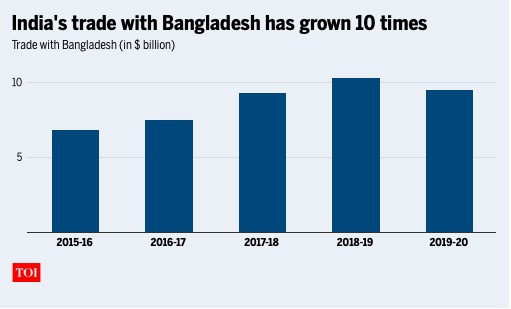
From: April 1, 2021: The Times of India
Explained: Why India, Pakistan are talking trade again
The news
Pakistan has allowed private companies to import sugar and cotton from India. The move signals a revival of trade ties between the two neighbours. "India desires normal relations, including on trade with all countries, including Pakistan. Pakistan unilaterally suspended bilateral trade with India in August 2019. It is for Pakistan to review its unilateral measures on trade," minister of state for commerce and industry Hardeep Singh Puri had said in the Lok Sabha last month.
The freeze
After the Pulwama terror attack in February 2019, India withdrew the 'most-favoured nation' (MFN) status it had unilaterally granted to Pakistan in 1996 as a member of World Trade Organisation (a Pakistan cabinet decision of November 2, 2011 to reciprocate remains unimplemented). Withdrawing MFN status meant India could make all goods imported from Pakistan more expensive (and therefore unviable) by imposing a customs duty of 200% on them. This was followed by suspension of cross-border trade in April 2019, which India then said was being misused for funnelling in illegal weapons, narcotics, and fake currency. Pakistan announced complete suspension of all bilateral trade after the Indian government revoked the special status of Jammu and Kashmir on August 5, 2019. Pakistan made a partial relaxation in September 2019 for trade in medicines.
The thaw
There’s been a gradual thawing in ties between the two neighbours since the announcement of ceasefire along the Line of Control in February this year. This was followed by Pakistani Prime Minister Imran Khan advocating dialogue between the two countries and its army chief talking of stable ties. Prime Minister Narendra Modi had also written a letter to PM Khan extending greetings on the occasion of Pakistan Day on March 23.
The need
While it is yet to be seen if trade between the two countries will expand across all commodities, the choice of sugar and cotton to make a start wasn’t surprising. Pakistan was one of the leading buyers of Indian cotton before the trade ban two years ago (it imported over $550 million of cotton in 2018-19). But recently, there have been reports of Pakistan’s textile sector struggling to source cotton at the right price following a low yield of cotton in the country. India is not just the world's biggest producer of cotton, it can offer the commodity to its neighbour at cheaper rates than suppliers from other countries.
India is also the second biggest sugar producer and Pakistan has been facing a crisis with domestic sugar prices soaring. Its attempts to tap the international market haven’t borne fruit due to the high cost. Pakistani traders have been buying Indian sugar from their offices in Dubai or Afghanistan, according to Reuters, but with direct imports from India, the cost comes down substantially. While sugar imports will help Pakistan lower soaring prices ahead of Ramadan, it will also help India reduce surpluses that are weighing on its local markets.
The trade
Trade relations between India and Pakistan have always mirrored the political ties between the two neighbours. And this means direct trade has remained more or less stagnant (indirect and informal trade through Dubai isn’t accounted for in the official numbers). Before the ban, trade between both nations had stood at just $2.5 billion in 2018-19, accounting for a mere 0.3% of India’s total trade with the world and just over 3% of Pakistan’s global trade. The ban dried even that up. In calendar year 2020, India’s exports to Pakistan dipped 76.3% to $283 million while imports plummeted 96.2% to just $2.5 million. In contrast, India’s trade with its eastern neighbour Bangladesh has grown in recent years.
Advantage India
Though the volume of trade between India and Pakistan has been low, the balance of trade has been heavily skewed in favour of India, which means India sells much more to Pakistan than it buys. Opening up of bilateral trade, therefore, will be more beneficial to India.
India mainly exports cotton, dyes, chemicals, plastics, vegetables and iron and steel. It imports fruits, cement, leather and spices.
The potential
What if the two largest economies in South Asia traded like normal neighbours?
According to a 2018 World Bank study (A Glass Half Full: The Promise of Regional Trade in South Asia), the trade potential between India and Pakistan stands at $37 billion. The report also highlighted how India and Pakistan maintained long, sensitive lists of items on which no tariff concessions are granted but in practice many of these items reach Pakistan via a third country like the United Arab Emirates, adding to the cost. The lack of normal bilateral trade relations also affects the formation or deepening of regional value-chains in many high-value trading sectors, the report highlighted.
E-commerce
Amazon's e-commerce 'bridge'
Indian merchants registered as sellers on Seattle-based online retail giant Amazon could soon find more buyers in Pakistan, if the company’s bid to increase its holding in a Pakistan-based fashion portal Clicky.pk proves successful, according to four people aware of the ongoing negotiations between Amazon and Clicky.pk.
Amazon already owns about 33% stake in Clicky.pk through its acquisition in 2017 of online retailer Souq, which is based in Dubai. Souq had invested in the Pakistani company in late 2016. “If a transaction (between Amazon and Cicky.pk) goes through Indian merchants can sell more goods in Pakistan, which can be routed through Dubai, where Souq is based,” said one of the people cited above.
Pakistan has a negative list of about 1,200 goods that cannot be imported from India. This has encouraged informal trade between the two countries routed largely through Dubai and occasionally Afghanistan.
According to a 2016 ICRIER paper, informal trade between the two South Asian neighbours for fiscal 2013 was pegged at $4.7 billion, dominated by exports from India. The formal trade between the two countries that year was $2.6 billion and was down to $2.3 billion in fiscal 2017.
“Several Indian FMCG products are popular in Pakistan. But a major chunk of products are raw material, unbranded food item, clothing and jewellery,” the sources told ET. Typically, most of these products are routed through Dubai and the big traders in Karachi who import these products, from where they are distributed across the country, the person added.
Amazon declined to comment for this story. Clicky.pk did not reply to email queries from ET.
For Amazon, raising its stake in Clicky.pk will also provide the American company with a firmer foothold in a market that China’s Alibaba is also eyeing keenly. Alibaba, is also in talks to pick up a stake in Rocket Internet-owned Daraz, one of the largest online commerce platforms in Pakistan, according to a Bloomberg report last month.
Clicky.pk competes with players like Daraz. Pakistan’s online commerce market was estimated to be worth $100 million in 2017.
Clicky.pk had raised nearly $1million by selling 33% stake to Souq in late 2016. In 2017 Amazon completed the acquisition of Souq for $580 million. The deal between Souq and Clicky.pk was not reported till now.
Experts are of the view that Amazon will look to consolidate its presence in the Indian subcontinent and the Middle East. “These three geographical locations — India, Dubai and Pakistan — makes sense for Amazon to scale up. Amazon will make entry into multiple Asian countries, a new strategy to increase its volume, optimise its sourcing and reduce single-country dependence for revenue flow,” said one of the sources mentioned above.
E-commerce in Pakistan is set to cross $1 billion by 2020 from $100 million last year, according to a recently published report by the Pakistan Telecommunication Authority (PTA). In comparison, India’s online retail market was pegged between $18 billion and $20 billion in 2017 with overall ecommerce market, which includes areas like online travel, estimated to be worth over $33 billion.
"Both Alibaba and Amazon will be interested in Pakistan, which has 70% mobile phone penetration in its 220 million population," said Adam Ghaznavi, a serial entrepreneur who had led Rocket Internet's Easy Taxi and ecommerce site Kaymu.pk in Pakistan. "The China Pakistan Economic Corridor is also bringing in lot of Chinese investment to the country, which will attract investors," he added.
Most-Favoured-Nation (MFN) status
MFN: a backgrounder
February 16, 2019: The Times of India
India withdrew the 'most-favoured nation' or MFN status to Pakistan after a terror attack which took lives of at least 40 CRPF (Central Reserve Police Force) personnel in Jammu and Kashmir. The country is considering punitive actions like significant hike in customs duties, port curbs and ban on goods imported from Pakistan.
This is one of the deadliest terror attacks in Jammu and Kashmir when a suicide bomber rammed a vehicle carrying over 100 kg of explosives into their bus in Pulwama district.
The move to remove MFN status would enable India to increase customs duty on goods coming from the neighbouring nation.
When was it given to Pakistan:
India granted the MFN status to Pakistan way back in in 1996, but the neighbouring country has not yet reciprocated.
In 2012, Pakistan had committed to giving the MFN status to India but retracted later. Instead of MFN, Pakistan said it was working on granting Non-Discriminatory Market Access (NDMA) status to India but that also was not announced.
The MFN status was accorded under WTO's General Agreement on Tariffs and Trade (GATT). Both India and Pakistan are signatories to this; and are members of the World Trade Organisation (WTO), which means they have to treat each other and the other WTO member countries as favoured trading partners in terms of imposing customs duties on goods.
What happens when India removes MFN status:
Removal of this status means India can now enhance customs duties to any level on goods coming from Pakistan, a trade expert said.
Withdrawal of the MFN status would significantly hit Pakistan's exports to India, which stood at $488.5 million (around Rs 3,482.3 crore) in 2017-18.
Last year in November, a senior aide to Pakistan's Prime Minister Imran Khan had said that the country has "no immediate plans" to grant MFN status to India. Pakistan allows only 137 products to be exported from India through the Wagah border land route.
Total India-Pakistan trade has increased marginally to $2.41 billion in 2017-18 as against $2.27 billion in 2016-17. India imported goods worth $488.5 million in 2017-18 and exported goods worth $1.92 billion in that fiscal.
Under MFN pact, a WTO member country is obliged to treat the other trading nation in a non-discriminatory manner, especially with regard to customs duty and other levies.
What India imports and exports:
India mainly exports cotton, dyes, chemicals, plastics, vegetables and iron and steel; while it imports fruits, cement, leather and spices.
The main items which Pakistan exports to India include fresh fruits, cement, petroleum products, bulk minerals and ores and finished leather.
The CCS meet was chaired by Prime Minister Narendra Modi to discuss the security scenario in J&K in the wake of the Pulwama terror attack.
Pros of MFN:
MFN status is helpful for the developing nations. The countries with the status have broader access to a market for trade goods, reduced cost of export items owing to highly reduced tariffs and trade barriers.
It also reduces the bureaucratic hurdles and varied kinds of other tariffs for imports. It then increases demands for the goods and giving a boost to the economy and export sector.
What commerce ministry said:
The commerce ministry would soon notify to the World Trade Organization (WTO) its decision to revoke the MFN status to Pakistan on security grounds, an official said. The ministry would work on a list of goods imported from Pakistan over which India would increase the customs duties.
2016: India considers taking Pak to WTO
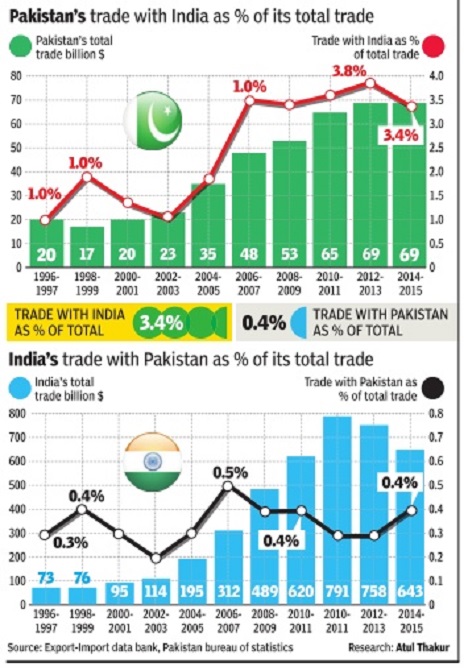
The Times of India
India may drag Pak to WTO on MFN, dispute Sep 28 2016 : The Times of India
A meeting convened PM Modi explored the option of dragging Pakistan to the World Trade Organisation's (WTO) dispute resolution body for refusing to reciprocate for 20 years India's granting of the Most Favoured Nation status to Pakistan. But New Delhi might not consider withdrawal of Pakistan's status, government sources said. What is Most-Favoured-Nation (MFN) status?
Under the World Trade Organization (WTO) agreements, countries cannot normally discriminate among their trading partners. If a country grants another country a special favour (e.g. lower customs duty on imports) then it has to offer the same favour to all WTO members.
Each member treats all the other members equally as “most-favoured“ trading partners.
The benefits of MFN status is available only to WTO members.
However, countries can enter into preferential trade agreements and free trade agreements to grant access and favours over and above MFN.
India-Pakistan MFN India granted Pakistan MFN status in 1996, and Pa kistan is yet to reciprocate. Trade between the two countries never really normalized. Total annual official trade between the two countries was $2.5 billion in 2015-16, whereas annual unofficial trade is estimated to be nearly $15 billion. A section of Pakistan's industry feels Indian goods will swamp Pakistan if Islamabad grants MFN status to India. There have been talks of granting Non-Discriminatory Market Access (NDMA) to India, which experts believe is MFN in another name.
Can India withdraw MFN status to Pakistan? India can move WTO and request for withdrawal of MFN status to Pakistan, citing breach of security . Article 21(b) (III) of WTO rules says that “nothing in this agreement shall ... prevent any WTO member from taking any action it considers necessary for the protection of its...security interest taken in time of war or other emergency in international relations.“
What would happen if India withdraws MFN status?
Exports from India will be choked, hurting consumers in some sectors. Trade through the Attari Wagah border will be hurt. According to a Ficci survey , steel costs in Pakistan would go down by 55%, engineering goods by 26%, bicycles by 20% and pharmaceuticals by 35% if they are imported from India through direct trade channels. Fruits and vegetables would be cheaper by 40% and sugar by 30%. The survey had said that liberalized trade in agriculture would help generate 2.7 lakh jobs in India and 1.7 lakh in Pakistan.
Trade
1995-2018

What they export to each other.
Reliance on each other’s exports.
From: August 20, 2019: The Times of India
See graphic:
Pakistan- India trade, 1995-2018
What they export to each other.
Reliance on each other’s exports.
Worker remittances and other inflows, outflows
2016
Omer Farooq Khan, Pak probes Sharif for ‘laundering’ $5bn to India, May 9, 2018: The Times of India
Dealing yet another blow to deposed Pakistan Prime Minister Nawaz Sharif, the country’s anti-graft watchdog, the National Accountability Bureau, on Tuesday ordered an inquiry against him for allegedly laundering $4.9 billion to India.
A NAB statement said bureau chairman Justice Javed Iqbal (Retd) has taken notice of a media report claiming that the incident was mentioned in World Bank’s Migration and Remittances Book 2016. The statement, however, has not mentioned details of the media report in question. The press release claimed, “The amount was laundered to the Indian finance ministry after which Indian foreign exchange reserves witnessed an increase while Pakistan had suffered as a result.”
Claims of $5bn in Pak fund flow false, says bank
However, in a press release issued on September 21, 2016, the State Bank of Pakistan (SBP) had rejected the estimates of $4.9 billion remittances from Pakistan to India and had termed it contrary to facts.
SBP said the outflow of $4.9 billion was cited in the Migration and Remittances Fact Book 2016, prepared by the Global Knowledge Partnership on Migration and Development. “It must be noted that the Fact Book data suggests estimates (not actual flows), which are based on a number of assumptions,” it said.
The SBP said the data of balance of payments showed that $116,000 worth of worker remittances flew from Pakistan to India in FY16 and inflows from India to Pakistan stood at $329,000.
The NAB probe comes as a setback to Sharif, who had to quit as PM following the SC verdict in the Panama Papers case that had disqualified him from office in July 2017. Sharif is not only facing three corruption cases, but the NAB also initiated a probe against him for alleged illegal expansion of a road leading to his estate in Lahore. Once formulated, it will be his fifth NAB case.
The accountability court on Tuesday sought more time from the Pakistan SC to end the trial on references filed by the NAB against members of the Sharif family.
See also
Pakistan- India economic relations
Pakistan- India: Cease-fire and its violations
Nuclear weapons testing: India- Pakistan
Nuclear arsenals: India, Pakistan
and many more articles, especially about the 1965 and 1971 wars, The Kargil war of 1999, 1947...
